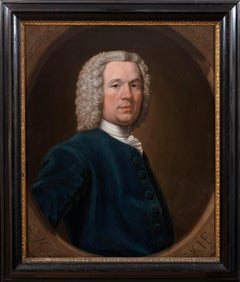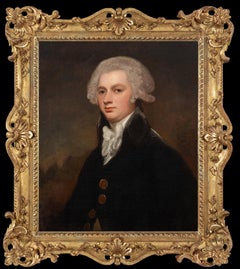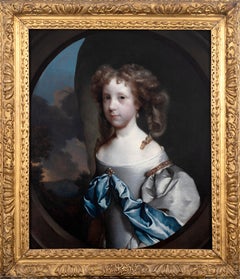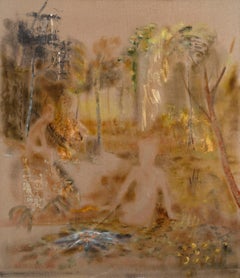Want more images or videos?
Request additional images or videos from the seller
1 of 10
Hunting trophy with a deer and game, adorned with the accoutrements of the chase1700-1720
1700-1720
Price:$17,260.36
$21,431.60List Price
About the Item
- Creation Year:1700-1720
- Dimensions:Height: 45.52 in (115.6 cm)Width: 57.09 in (145 cm)Depth: 3.94 in (10 cm)
- Medium:
- Movement & Style:
- Circle Of:Jan Weenix (1642 - 1719, Dutch)
- Period:1700-1709
- Condition:The work is in good and stable condition. Light craquelure throughout the paint surface, commensurate with age. Relined and restored in the c. 1980s, with areas of overpaint focussing around the middle and upper centre.
- Gallery Location:Henley-on-Thames, GB
- Reference Number:1stDibs: LU2820215758032
About the Seller
No Reviews Yet
Vetted Professional Seller
Every seller passes strict standards for authenticity and reliability
Established in 2024
1stDibs seller since 2024
Authenticity Guarantee
In the unlikely event there’s an issue with an item’s authenticity, contact us within 1 year for a full refund. DetailsMoney-Back Guarantee
If your item is not as described, is damaged in transit, or does not arrive, contact us within 7 days for a full refund. Details24-Hour Cancellation
You have a 24-hour grace period in which to reconsider your purchase, with no questions asked.Vetted Professional Sellers
Our world-class sellers must adhere to strict standards for service and quality, maintaining the integrity of our listings.Price-Match Guarantee
If you find that a seller listed the same item for a lower price elsewhere, we’ll match it.Trusted Global Delivery
Our best-in-class carrier network provides specialized shipping options worldwide, including custom delivery.You May Also Like
Fine 18th Century Old Master Oil Painting Dead Game in Landscape
Located in Cirencester, Gloucestershire
Still Life with Dead Birds
18th Century Italian School
oil painting on canvas, framed
framed: 16 x 20 inches
canvas: 13 x 17 inches
provenance: privat...
Category
18th Century Old Masters Animal Paintings
Materials
Oil
$1,805 Sale Price
30% Off
H 16 in W 18 in
Fine 18th Century Old Master Oil Painting Dead Game in Landscape
Located in Cirencester, Gloucestershire
Still Life with Dead Birds
18th Century Italian School
oil painting on canvas, framed
framed: 17 x 21 inches
canvas: 14 x 18 inches
provenance: private collec...
Category
18th Century Old Masters Animal Paintings
Materials
Oil
$1,762 Sale Price
30% Off
H 17 in W 21 in
Table Top Still Life with Birds, Fruit and Walnuts - Old Master art oil painting
Located in Hagley, England
This simply stunning German 18th century Old Master oil painting is by noted artist C.L. Braun, signed lower right on the table edge. It was painted circa 1780 and has the look of a...
Category
1780s Old Masters Still-life Paintings
Materials
Oil
$5,987 Sale Price
20% Off
H 33 in W 40 in D 2 in
17th century By Dutch Maestro Still life with bird, carp & lobster Oil on canvas
Located in Milano, Lombardia
17th Century Dutch Maestro
Title: Still life with bird, carp & lobster
Medium: Oil on canvas
Dimensions: without frame 116 x 97 cm - with frame 153 x 133,5 cm
Antique frame "a casset...
Category
17th Century Old Masters Still-life Paintings
Materials
Canvas, Oil
$20,066 Sale Price
20% Off
H 45.67 in W 38.19 in D 1.97 in
A Tompe l'oeil still life of hanging birds
Located in Stoke, Hampshire
English School, c. 1800
Still life of hanging birds
Oil on panel
Panel size - 8 x 6 in
Framed size - 12 1/2 x 10 1/2 in
This trompe-l'œil still life is a striking example of illusio...
Category
19th Century Old Masters Animal Paintings
Materials
Oil
Still Life of Spaniels and Falcons in Landscape Setting by Carstian Luyckx
Located in SANTA FE, NM
Still Life of Game with Dogs and Spaniels in a Landscape Setting
Carstian Luyckx (Flemish, 1623 – c.1675)
Oil on canvas
Circa 1670
Unsigned
43 ½ x 59 1/8 in.; Frame 52 7/8 x 68 7/8...
Category
1660s Old Masters Animal Paintings
Materials
Canvas, Oil
Exceptional Italian 17th Century Still-Life Painting Wit a Red Parrot and Fruits
By Abraham Brueghel
Located in Rome, IT
17' century Still-life oil on canvas with Fruits and an amazing red parrot background with landscape and garden with architectural elements.
Gilt painted frame .
It is attribute...
Category
Late 17th Century Old Masters Still-life Paintings
Materials
Oil
$65,322
H 57.09 in W 74.81 in D 1.97 in
18th century portrait of a Spaniel dog with fruit in a wooded landscape.
By Tobias Stranover
Located in Woodbury, CT
Outstanding early 18th-century portrait of a seated Spaniel dog in a landscape with an array of fruits.
Attributed to the work of Tobias Stranover.
...
Category
1730s Old Masters Animal Paintings
Materials
Oil
$19,500
Free Shipping
H 24.5 in W 34.5 in
Freshwater fish, an eel and a frog, on a table
Located in Stoke, Hampshire
Isaac Van Duynen (Dordrecht 1628-1679 The Hague)
Freshwater fish, an eel and a frog, on a table
Oil on canvas
Canvas size 37 x 51 in
Framed size 44 x 58 in
Provenance
with Simon Dic...
Category
17th Century Old Masters Animal Paintings
Materials
Oil
Mockery and Hate - Norse Mythology Still Life with Flowers and Animal Skull
By Matthew Cook
Located in Chicago, IL
Mockery and Hate are the English translations of Sköll and Hati, the Norse mythological wolves that chase the Sun and Moon across the sky and ultimately devour them at Ragnarok. They...
Category
2010s Old Masters Still-life Paintings
Materials
Oil, Acrylic
$10,000
H 33 in W 37 in D 4 in
More From This Seller
View AllPortrait of George Gordon, 7th Laird of Buckie (1707-1756)
By John Alexander
Located in Henley-on-Thames, England
John Alexander (Scottish, 1686-1766)
Portrait of George Gordon, 7th Laird of Buckie (Scottish, 1707-1756), c. 1743
Oil on canvas
In a carved ebonised frame, with gilded inner slight...
Category
1740s Old Masters Portrait Paintings
Materials
Oil
$8,164 Sale Price
20% Off
Portrait of a Gentleman, traditionally identified as Edward Addison, Esq., 1780s
By George Romney
Located in Henley-on-Thames, England
George Romney (1734-1802)
Portrait of a Gentleman, traditionally identified as Edward Addison, Esq., c.1780s
Oil on canvas
In a period carved and gilded swept frame
76.3 x 63.2 cm.; ...
Category
1780s Old Masters Portrait Paintings
Materials
Oil
Portrait of a girl, possibly Dorothy Bigg (née Wither) (1661-1717), c. 1674
By Gerard Soest
Located in Henley-on-Thames, England
Gerard Soest (c. 1600-1681)
Portrait of a girl, possibly Dorothy Bigg (née Wither) (1661-1717), c. 1674
Half-length, wearing natural pearl and gemstone jewellery
Oil on canvas
In...
Category
1670s Old Masters Portrait Paintings
Materials
Oil
Cinder
Located in Henley-on-Thames, England
Joel Tomlin (b. 1969)
Cinder, 2004
Oil on linen
Signed and titled verso
183 x 157 cm.
Provenance:
Joel Tomlin;
MW Projects, London, 2004;
Permanent Collection, Saatchi Gallery;
Chri...
Category
Early 2000s Contemporary Landscape Paintings
Materials
Oil
$3,537 Sale Price
60% Off
Green Shoots
Located in Henley-on-Thames, England
Michael Chance (B. 1987)
Green Shoots, 2021
Oil on canvas
Signed lower left
Titled, signed and dated verso
153.5 x 122 cm.
Provenance:
Michael Chance;
Private Collection, United ...
Category
2010s Cubist More Art
Materials
Oil
Portrait tête d’expression portrait study of a gentleman
Located in Henley-on-Thames, England
French Academic School, 18th century
Portrait tête d’expression study of a gentleman, c. 1780-90
Oil on canvas
46.1 x 35 cm.; (within frame) 57.5 x 46.6. cm.
Provenance:
Private Co...
Category
1780s French School Portrait Paintings
Materials
Oil



